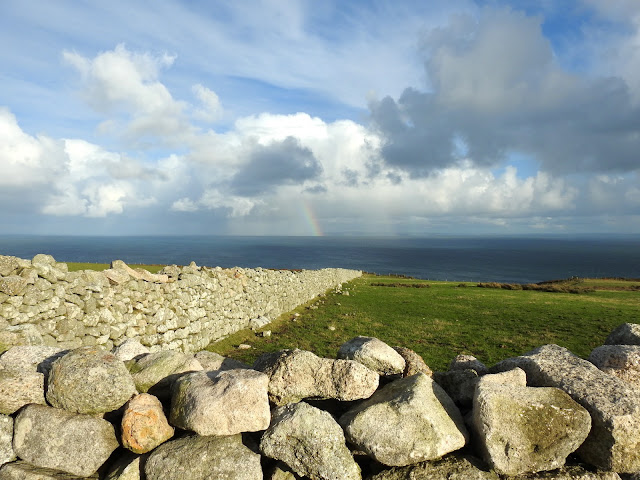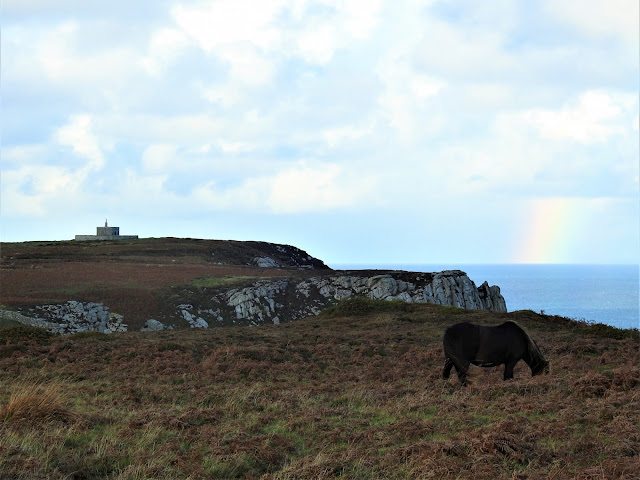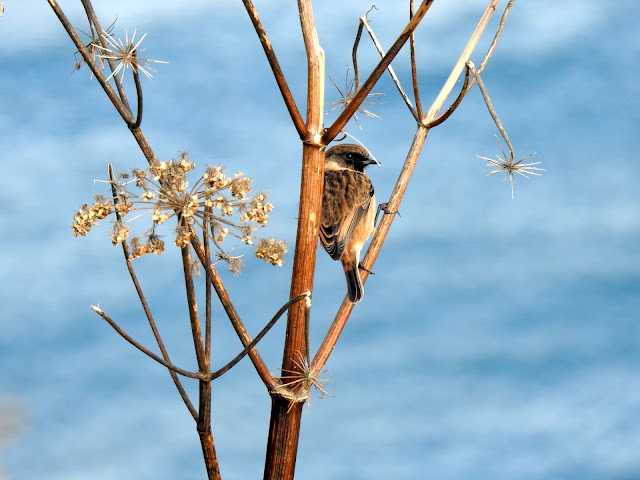Eleanor Grover summarises eight days of avian activity on Lundy.
13th November
A bright and calm day – decidedly warmer than the past few days.
The heat and sunshine did not feel like November! The insects were testimony to this: three Red Admirals, an unidentified white butterfly and several Buff-tailed Bumblebees were on the wing.
The day started off with three very confiding Bramblings feeding around Brambles Villa. Other finches seen included 13 Chaffinches, three Goldfinches and seven Siskins. Five thrush species were recorded: seven Blackbirds, 22 Fieldfares, 55 Redwings, two Song Thrushes and a Mistle Thrush. A tiny Goldcrest and, not much larger, three Chiffchaffs were logged. On the slightly larger ‘little brown job’ front, four Skylarks, six Meadow Pipits and five Rock Pipits were counted.
A Blackcap and four Stonechats were along the Upper East Side Path, along with a potential sighting of a Short-eared Owl. Unfortunately, the bird was only glimpsed before it dropped out of sight and so its identity couldn't be confirmed.
Two Woodpigeons exploded out of the treetops and below them a Woodcock performed a similarly sudden take-off. Other waders of the day included a Snipe and three Oystercatchers. Out at sea, four Shags, two Great Black-backed Gulls and 10 Herring Gulls were counted. Another seabird was seen closer to shore: an exhausted-looking Guillemot taking shelter in the Landing Bay.
14th November
Very light rain in the morning, eventually lifting to a bright, if grey, day. Temperatures remained mild.
Despite the gloomy weather, it was a good day for birds. A Stock Dove hunkered down at the top of Barton Field, perhaps seeking to hide from the noisy flock of well over 1,500 Starlings that dominated the lower half of the field. This rabble could be heard from the far end of the Village! Admixed into the squabbling mass were 14 Fieldfares and 45 Redwings.
Blackbirds were also very prominent, with 15 counted in Millcombe Valley alone. Also in Millcombe were five Chiffchaffs, four Blackcaps, a Goldcrest, four Song Thrushes, a Mistle Thrush, 23 Chaffinches, three Bramblings, a Goldfinch and a Siskin. Two Woodpigeons clapped their way across the valley and two Woodcocks chose the same bush to explode out of, one after the other.
Pausing to search the Walled Gardens once again paid dividends, revealing a surprise Barred Warbler! Whist not much to look at, this subtle bird had a very charming personality – often feeding out in the open and becoming more confiding as the day went on. Only disappearing a handful of times, the warbler always returned to the Walled Gardens and remained there for most of the day. This constitutes the latest ever record of Barred Warbler for Lundy.
A bright and calm day – decidedly warmer than the past few days.
The heat and sunshine did not feel like November! The insects were testimony to this: three Red Admirals, an unidentified white butterfly and several Buff-tailed Bumblebees were on the wing.
The day started off with three very confiding Bramblings feeding around Brambles Villa. Other finches seen included 13 Chaffinches, three Goldfinches and seven Siskins. Five thrush species were recorded: seven Blackbirds, 22 Fieldfares, 55 Redwings, two Song Thrushes and a Mistle Thrush. A tiny Goldcrest and, not much larger, three Chiffchaffs were logged. On the slightly larger ‘little brown job’ front, four Skylarks, six Meadow Pipits and five Rock Pipits were counted.
A Blackcap and four Stonechats were along the Upper East Side Path, along with a potential sighting of a Short-eared Owl. Unfortunately, the bird was only glimpsed before it dropped out of sight and so its identity couldn't be confirmed.
Two Woodpigeons exploded out of the treetops and below them a Woodcock performed a similarly sudden take-off. Other waders of the day included a Snipe and three Oystercatchers. Out at sea, four Shags, two Great Black-backed Gulls and 10 Herring Gulls were counted. Another seabird was seen closer to shore: an exhausted-looking Guillemot taking shelter in the Landing Bay.
14th November
Very light rain in the morning, eventually lifting to a bright, if grey, day. Temperatures remained mild.
Despite the gloomy weather, it was a good day for birds. A Stock Dove hunkered down at the top of Barton Field, perhaps seeking to hide from the noisy flock of well over 1,500 Starlings that dominated the lower half of the field. This rabble could be heard from the far end of the Village! Admixed into the squabbling mass were 14 Fieldfares and 45 Redwings.
Blackbirds were also very prominent, with 15 counted in Millcombe Valley alone. Also in Millcombe were five Chiffchaffs, four Blackcaps, a Goldcrest, four Song Thrushes, a Mistle Thrush, 23 Chaffinches, three Bramblings, a Goldfinch and a Siskin. Two Woodpigeons clapped their way across the valley and two Woodcocks chose the same bush to explode out of, one after the other.
Pausing to search the Walled Gardens once again paid dividends, revealing a surprise Barred Warbler! Whist not much to look at, this subtle bird had a very charming personality – often feeding out in the open and becoming more confiding as the day went on. Only disappearing a handful of times, the warbler always returned to the Walled Gardens and remained there for most of the day. This constitutes the latest ever record of Barred Warbler for Lundy.
 |
| Lundy's latest ever Barred Warbler feeding in Millcombe's Walled Gardens © Eleanor Grover |
Elsewhere around the island, two Oystercatchers, a Great Black-backed Gull, two Herring Gulls, nine Skylarks, two Stonechats, a Meadow Pipit and a Linnet were logged. Another pleasant surprise was a single Whinchat.
15th November
Once again unseasonably warm – grey with occasional blue skies interspersed – mist out at sea fortunately did not shroud the island.
A quiet day, in part because the noisy Starling flock had dispersed and moved on. Yet, over 200 individuals were still scattered around the island in smaller flocks. On the other hand, Blackbirds appeared to be everywhere, 38 counted, alongside 19 Fieldfares and 107 Redwings. Some highest counts for the week included seven Mallards, six Ravens and nine Dunnocks.
Millcombe Valley revealed mostly finches (six Chaffinches, three Bramblings, four Goldfinches and 18 Siskins) and a Goldcrest. Around the southern end of the island, counts included three Great Black-backed Gulls, 16 Herring Gulls, a Skylark, a Stonechat, three Meadow Pipits and a Rock Pipit.
16th November
Intermittent showers of very fine drizzle.
Unfazed by the wet day, wet-loving species seen included an Oystercatcher, a Woodcock, a Snipe, two Great Black-backed Gulls, 15 Herring Gulls and a Shag. A total of 43 House Sparrows huddled together around the Farmyard and two rather soggy-looking Stonechats were seen together on Ackland’s Moor.
On the thrush front, counts included 24 Blackbirds, three Fieldfares, 57 Redwings and four Song Thrushes. The rattling call of a Mistle Thrush was once again heard in Millcombe Valley, along with two Blackcaps, a Firecrest, five Goldcrests, 11 Chaffinches, four Bramblings, four Goldfinches and 17 Siskins. Three Chiffchaffs were noted, including a very pale individual. Unfortunately, this bird refused to call and hastily dropped out of sight, avoiding further scrutiny.
Flyovers included two Skylarks, a Pied Wagtail, two Meadow Pipits and a Rock Pipit. A Sparrowhawk laboured its way along the East Side and two Snow Buntings were seen on the main track near Threequarter Wall.
17th November
A fine day with blue skies and warmer temperatures.
Better weather for people but not for birds! Eight Blackbirds, one Fieldfare and 22 Redwings were the only thrushes recorded throughout the day. Finches were even scarcer, with just two Chaffinches and two Goldfinches. However, things were picking up again out at sea, with three Herring Gulls being joined by 10 Gannets and 20 Fulmars.
The screeching calls of two Peregrines were heard mixing in with the deep ‘cronks’ of six Ravens. A single Snow Bunting delighted many visitors as it stuck to the track between Halfway and Threequarter Walls. Other species recorded included: three Woodpigeons, three Snipe, a Skylark, two Chiffchaffs, two Stonechats (a male and a female), four Meadow Pipits and two Rock Pipits.
 |
| Blending in with the gravel – this Snow Bunting seemed oblivious to the rain © Eleanor Grover |
18th November
Once again, back to rain showers and mizzle.
A little bit of seawatching once again provided records of a few extra species: five Great Black-backed Gulls, seven Herring Gulls, a Lesser Back-backed Gull, 15 Gannets, four Shags and one Cormorant were all recorded from the East Side. The shrill calls of two Oystercatchers were heard from further down the coast, and two Woodcocks were flushed from the undergrowth.
Two Song Thrushes mixed with 71 Redwings and 11 Blackbirds. Counts of small birds included a Skylark, three Chiffchaffs, four Meadow Pipits, five Bramblings, five Goldfinches and two Siskins. Two Goldcrests were joined by a single Firecrest. Ten Chaffinches were kept on their toes throughout the day by the presence of a female Merlin, espied hunting in Millcombe Valley, Barton Field and St John’s Valley, though not having a very successful day. In chasing prey, she would relentlessly streak after it, twisting and turning as she attempted to snatch it in mid-air. The two Woodpigeons were large enough to just laugh at her presence and 11 Carrion Crows took it upon themselves to mob her. Not a good day to be a Merlin!
19th November
Continuing with this week’s theme: intermittent mizzle showers.
Even the birds seemed to be getting fed up with the weather, with relatively few species logged. Counts included: three Woodpigeons, a Great Black-backed Gull, two Herring Gulls and two Gannets. Also recorded were three Chiffchaffs, a Goldcrest, 26 Redwings, a Song Thrush, a Pied Wagtail, one Meadow Pipit, 10 Chaffinches and a Siskin. Blackbird numbers have decreased, just three noted. Highlights included 21 Bramblings and four Water Rails that were heard calling from their respective territories. What with their squeals, shrieks and various screams, perhaps they should be called ‘Water Wails’ instead!
Once again, back to rain showers and mizzle.
A little bit of seawatching once again provided records of a few extra species: five Great Black-backed Gulls, seven Herring Gulls, a Lesser Back-backed Gull, 15 Gannets, four Shags and one Cormorant were all recorded from the East Side. The shrill calls of two Oystercatchers were heard from further down the coast, and two Woodcocks were flushed from the undergrowth.
Two Song Thrushes mixed with 71 Redwings and 11 Blackbirds. Counts of small birds included a Skylark, three Chiffchaffs, four Meadow Pipits, five Bramblings, five Goldfinches and two Siskins. Two Goldcrests were joined by a single Firecrest. Ten Chaffinches were kept on their toes throughout the day by the presence of a female Merlin, espied hunting in Millcombe Valley, Barton Field and St John’s Valley, though not having a very successful day. In chasing prey, she would relentlessly streak after it, twisting and turning as she attempted to snatch it in mid-air. The two Woodpigeons were large enough to just laugh at her presence and 11 Carrion Crows took it upon themselves to mob her. Not a good day to be a Merlin!
19th November
Continuing with this week’s theme: intermittent mizzle showers.
Even the birds seemed to be getting fed up with the weather, with relatively few species logged. Counts included: three Woodpigeons, a Great Black-backed Gull, two Herring Gulls and two Gannets. Also recorded were three Chiffchaffs, a Goldcrest, 26 Redwings, a Song Thrush, a Pied Wagtail, one Meadow Pipit, 10 Chaffinches and a Siskin. Blackbird numbers have decreased, just three noted. Highlights included 21 Bramblings and four Water Rails that were heard calling from their respective territories. What with their squeals, shrieks and various screams, perhaps they should be called ‘Water Wails’ instead!
Also seen flying in was not a bird but a birder! Our new Assistant Warden, Stuart Cossey, and his partner Megan arrived on the helicopter. We look forward to working with Stuart and, as an all-round excellent birder, we are sure that he will find many great bird sightings for this blog. Welcome to the team, Stuart!
20th November
Grey and drizzly, with occasional dry breaks.
A Ringed Plover was heard calling first thing and remained vocal, if invisible, throughout the morning. A Stock Dove was in Barton Field, and later joined four Woodpigeons in Millcombe Valley. Five Water Rails were heard calling, one of them sighted for once. Normally shy and skulking birds, it was a pleasure to see one trot across the path in Millcombe in the early morning.
Counts of ‘common’ species included two Oystercatchers, 16 Wrens, 11 Robins, 19 Blackbirds, 14 Meadow Pipits, three Rock Pipits, 12 Chaffinches, two Goldfinches, a Pied Wagtail and approximately 90 Starlings. Migratory species included 19 Bramblings, 137 Redwings, 26 Fieldfares, a Skylark and eight Siskins. Some migrants may have already made themselves at home on Lundy for the winter, such as the six Chiffchaffs, three Goldcrests and three Blackcaps that were recorded.
A lonesome female Teal was on Quarter Wall Pond and a Snow Bunting hopped along the track between Quarter Wall and Halfway Wall. An exciting find was three small ‘bait balls’ off the East Coast. Flocks of birds swirled around and minimum counts of 88 Herring Gulls, 16 Great Black-backed Gulls, eight Shags, three Gannets and 70 Kittiwakes gorged themselves on the underwater feast.
20th November
Grey and drizzly, with occasional dry breaks.
A Ringed Plover was heard calling first thing and remained vocal, if invisible, throughout the morning. A Stock Dove was in Barton Field, and later joined four Woodpigeons in Millcombe Valley. Five Water Rails were heard calling, one of them sighted for once. Normally shy and skulking birds, it was a pleasure to see one trot across the path in Millcombe in the early morning.
Counts of ‘common’ species included two Oystercatchers, 16 Wrens, 11 Robins, 19 Blackbirds, 14 Meadow Pipits, three Rock Pipits, 12 Chaffinches, two Goldfinches, a Pied Wagtail and approximately 90 Starlings. Migratory species included 19 Bramblings, 137 Redwings, 26 Fieldfares, a Skylark and eight Siskins. Some migrants may have already made themselves at home on Lundy for the winter, such as the six Chiffchaffs, three Goldcrests and three Blackcaps that were recorded.
A lonesome female Teal was on Quarter Wall Pond and a Snow Bunting hopped along the track between Quarter Wall and Halfway Wall. An exciting find was three small ‘bait balls’ off the East Coast. Flocks of birds swirled around and minimum counts of 88 Herring Gulls, 16 Great Black-backed Gulls, eight Shags, three Gannets and 70 Kittiwakes gorged themselves on the underwater feast.















